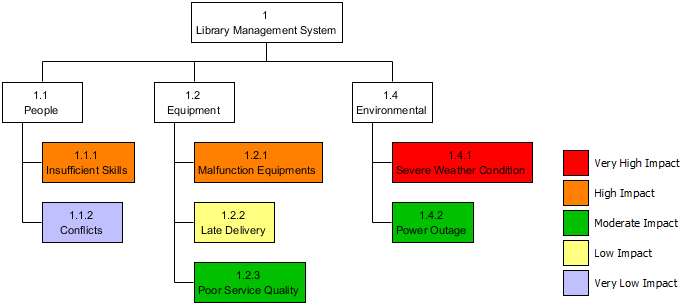Manajemen risiko adalah sistem untuk mengidentifikasi, menangani, dan menghilangkan masalah yang dapat merugikan biaya, jadwal, atau keberhasilan teknis suatu proyek atau moral tim proyek.
“Masalah besok adalah risiko hari ini.” Oleh karena itu, “risiko” didefinisikan dengan jelas sebagai masalah yang dapat menyebabkan kerusakan atau mengancam jadwal proyek, tetapi belum terjadi.
Jika Anda tidak mengambil inisiatif untuk mengelola risiko, Anda akan menghadapi risiko.
Pengembangan perangkat lunakadalah aktivitas berisiko tinggi, dan mungkin ada risiko di setiap tahap proses pengembangan proyek. Mengadopsi metode manajemen risiko yang aktif dapat membuat proses proyek lebih stabil, memperoleh kemampuan tinggi untuk melacak dan mengendalikan proyek, serta dapat menghindari dan mentransfer risiko, atau mengurangi dampak negatif dari risiko.
Manajemen risiko adalah proses mengidentifikasi, menganalisis, merespons, dan memantau risiko proyek. Ini adalah aktivitas manajemen yang sangat penting dalam manajemen proyek. Implementasi yang efektif dari manajemen risiko perangkat lunak adalah jaminan untuk penyelesaian yang lancar dari pengembangan proyek perangkat lunak.
Pencapaian manajemen risiko harus mencakup tiga elemen:
- Rencana manajemen risiko harus dirumuskan dalam rencana pengembangan proyek;
- Anggaran proyek harus mencakup dana yang diperlukan untuk menyelesaikan risiko;
- Saat menilai risiko, dampak risiko juga harus dimasukkan dalam perencanaan proyek.
Mari kita diskusikan bagaimana kita dapat mengambil tindakan pencegahan untuk mengurangi risiko yang sering terjadi selama pengembangan perangkat lunak.
- Persyaratan yang tidak jelas— Persyaratan yang tidak jelas adalah masalah yang sering ditemui dalam proses pengembangan perangkat lunak. Masalah semacam itu sering muncul dalam banyak aspek seperti ruang lingkup persyaratan yang tidak terdefinisi, persyaratan yang belum disempurnakan, deskripsi persyaratan yang tidak jelas, persyaratan yang hilang, dan persyaratan yang bertentangan. Dalam siklus hidup proses pengembangan perangkat lunak, pemborosan yang disebabkan oleh persyaratan yang tidak jelas adalah yang terbesar dan harus diselesaikan secepat mungkin. Sangat sulit untuk menentukan kebutuhan pengguna.
Tindakan Pencegahan
- Biarkan pengguna berpartisipasi dalam pengembangan melalui diskusi dan pertemuan yang singkat dan lebih sering
- Kembangkan dan komunikasikan dengan pemangku kepentingan menggunakan prototipe wireframe / antarmuka pengguna
2. Untuk proyek dengan distribusi pengguna yang luas dan jumlah pengguna yang besar, seringkali sulit untuk mengumpulkan persyaratan pengguna secara komprehensif, dan pertemuan penelitian persyaratan biasanya diadopsi untuk mengonfirmasi persyaratan.
Tindakan Pencegahan
Beberapa minggu sebelum pertemuan, kami melakukan survei kebutuhan pengguna di berbagai wilayah dan departemen, dan kemudian mengumpulkan perwakilan pengguna dari semua wilayah atau departemen untuk mengadakan seminar persyaratan untuk mengumpulkan persyaratan melalui pertemuan. Metode ini cocok untuk pengguna yang memiliki pengalaman TI tertentu.
2. Jebakan 80/20— Ketika seorang manajer proyek atau pengembang mengatakan bahwa 80% dari tugas telah diselesaikan, Anda harus berhati-hati. Karena 20% yang tersisa mungkin memakan 80% dari waktu, atau mungkin tidak pernah diselesaikan.
Proyek pengembangan perangkat lunak sering kali kurang terlihat dalam hal kemajuan proyek dan kualitas perangkat lunak. Semakin sedikit visibilitas proyek, semakin sulit untuk mengendalikan proyek, dan semakin besar kemungkinan proyek gagal. Kita dapat meningkatkan visibilitas proyek melalui pengembangan iteratif, tinjauan teknis, dan integrasi berkelanjutan.
Tindakan Pencegahan:
- Pengembangan iteratif Menggunakan model pengembangan iteratif, proses pengiriman produk dibagi menjadi beberapa tahap dan disampaikan secara bertahap sesuai dengan fungsi.
- Tinjauan teknis adalah bagian penting dari memastikan kualitas perangkat lunak. Tinjauan teknis mencakup drill kode, tinjauan pertemuan, dan tinjauan sejawat. Tinjauan kode dapat berupa tinjauan silang antara pengembang atau tinjauan pengembang biasa oleh pengembang senior; Tinjauan pertemuan umumnya dilakukan setidaknya sekali setiap dua minggu, dan waktu setiap tinjauan tidak boleh terlalu lama, yang merupakan jaminan penting untuk keberhasilan proyek.
- Integrasi berkelanjutan dapat membagi proses integrasi dan pengujian besar akhir menjadi kemajuan pengembangan mingguan dan harian proyek. Sehingga setiap orang dalam proyek dapat memahami kemajuan keseluruhan saat ini kapan saja, dan dengan cepat menemukan serta menyelesaikan masalah dalam proses integrasi.
3. Inovasi teknologiadalah aktivitas teknologi dan ekonomi yang eksploratif dan kreatif. Dalam proses pengembangan, memperkenalkan teknologi baru akan tak terhindarkan menghadapi berbagai risiko. Langkah-langkah seperti pengembangan perangkat lunak berbentuk T, dan prototyping dengan teknologi baru dengan cerita pengguna spike.
4. Masalah kinerja— Karena kurangnya wawasan desain perangkat lunak, masalah kinerja sering kali terungkap setelah menerapkan sistem atau menggunakan sistem baru untuk jangka waktu tertentu. Masalah kinerja biasanya memerlukan banyak pekerjaan optimasi, atau bahkan desain ulang sebagian atau menyeluruh. Baik pengguna maupun pengembang tidak menginginkan masalah kinerja. Tim perlu menyadari masalah ini, menerapkan perencanaan dan pengujian kinerja sepanjang proses pengembangan, dan memasukkan persyaratan kinerja dalam persyaratan non-fungsional.
5. Masalah kegunaanKegunaan perangkat lunak mencakup banyak faktor seperti apakah perangkat lunak efisien, mudah dipelajari, mudah diingat, menyenangkan, dan tidak mudah membuat kesalahan. Seringkali karena kegunaan perangkat lunak yang buruk, pengguna merasa tidak puas dan bahkan tereliminasi oleh pasar. Dalam pengembangan proyek, perhatian harus diberikan pada masalah kegunaan untuk menghindari risiko kegunaan perangkat lunak.
Struktur Pemecahan Risiko
Kita dapat menggunakan struktur pemecahan risiko untuk mengklasifikasikan risiko potensial untuk berbagai aspek:
Struktur pemecahan risiko adalah dekomposisi hierarkis dari risiko, dimulai dari elemen node akar yang mewakili proyek, dan turun ke berbagai kategori risiko, dan kemudian risiko tingkat yang lebih halus.
Selain menyajikan risiko proyek dalam Struktur Pemecahan Risiko, dimungkinkan untuk menggabungkan penggunaan Legenda Warna dalam mewakili dampak risiko. Lihat contoh Struktur Pemecahan Risiko di bawah ini, sebuah legenda Dampak dengan lima item telah disiapkan, mewakili lima tingkat dampak yang mungkin dimiliki risiko terhadap proyek dengan lima kode warna yang berbeda.
Berikut adalah contoh Struktur Pemecahan Risiko:

(Edit struktur pemecahan risiko ini secara online)
Ada banyak Alat Manajemen Risiko yang dapat Anda gunakan dalam menyusun risiko. Selain Struktur Pemecahan Risiko, Anda dapat mempertimbangkan untuk menggunakanDiagram Sebab dan Akibatjuga (juga dikenal sebagai Diagram Tulang Ikan).
Kesimpulan
Semakin awal risiko diidentifikasi dan dikelola, semakin besar kemungkinan untuk menghindari risiko, atau mengurangi dampak risiko ketika itu terjadi. Terutama dalam proyek kompleks dengan sejumlah besar peserta proyek, keterlibatan yang luas, dan konten teknis yang tinggi harus diperkuat.
This post is also available in Deutsch, English, Español, فارسی, Français, 日本語, Polski, Portuguese, Ру́сский, Việt Nam, 简体中文 and 繁體中文.













